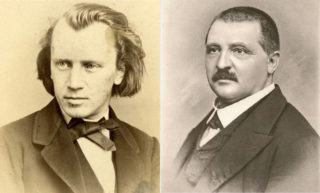Along Vienna’s Ringstraße
Sinfonieorchester Basel
22 and 23 May 2019
Wiebke Lehmkuhl, Alt
Andreas Liebig, Organ
Ivor Bolton, Conductor
Franz Schmidt - Fuga Solemnis
Gustav Mahler - Kindertotenlieder
Anton Bruckner - Symphony No. 6
This month’s program revolves around three Austrian composers who lived and worked at a time when Austrian culture blossomed like never before, while simultaneously the Austro-Hungarian empire was slowly unravelling under the pressure of nationalism. All three composers – Bruckner, Mahler and Schmidt – were born within the empire, although in different parts. While Mahler was born and raised in Jihlava in present-day Czechia, Schmidt in Bratislava (Slowakia) and Bruckner in the area around Linz, they all gravitated towards Vienna when the city went through a major growth spurt. Bruckner, the oldest of the three must have witnessed Vienna still confined within its medieval boundaries, but by the time Mahler studied in the capital the old ramparts were largely gone and the famous Ringstraße, with its temples of culture like the Musikverein and the Staatsoper, was taking shape.
It is against this backdrop that Bruckner composed his sixth symphony between 1879 and 1881. Although he considered this symphony his boldest, it never gained much traction, and in spite of some positive reviews after the premiere of the two middle movements in Vienna in 1883, it wasn’t until 1899, after Bruckner’s death, that Mahler conducted the complete symphony. Mahler’s attitude towards Bruckner evolved from reverence as a student to fairly critical later in life, hence the heavy editing he did for the 1899 performance.
Unlike Mahler, who never studied under Bruckner, Franz Schmidt (1874 – 1939) did follow his music theory and counterpoint classes. This and Bruckner’s reputation as an organist, could explain Schmidt’s profilic output of fugues for organ, of which the Fuga Solemnis is the latest. The piece and its composer have a history troubled by Nazism. Schmidt reportedly sympathized with the Nazis and after Austria’s Anschluss to Germany in 1938, the Fuga Solemnis was reworked and incorporated into a propagandistic cantata called the German Resurrection. As Schmidt’s alleged flirt with the Nazis is nowadays seen as naivety rather than conviction, his music is being reappreciated. He was a gifted musician, who played the cello in Vienna’s Court Opera Orchestra under Mahler, and later became the director of the conservatory and a respected composer. The orchestration of the Fugue -brass, timpani and tamtam- forms a nice complement to Mahler’s Kindertotenlieder that demand a chamber orchestra without trumpets.
Having lost eight of his siblings in their infancy, the Kindertotenlieder are a cycle of five songs on poems by Rückert that must have had a deep emotional meaning for Mahler, who, understandably, said that death is always near. Mahler finalized the orchestration of the songs, which he started in 1901, right after the birth of his second daughter in 1904, causing his wife to exclaim in despair that he was defying the odds. In a terrible twist of fate their oldest daughter died of scarlet fever in 1907, the same disease Rückert’s own two children had died of and which inspired him to write more than 400 poems of which Mahler scored five, a tragic highlight of Austria’s enormous musical heritage.
These English program notes have been published in the magazine (No. 8, 2018/2019) of the Sinfonieorchester Basel.








Comments